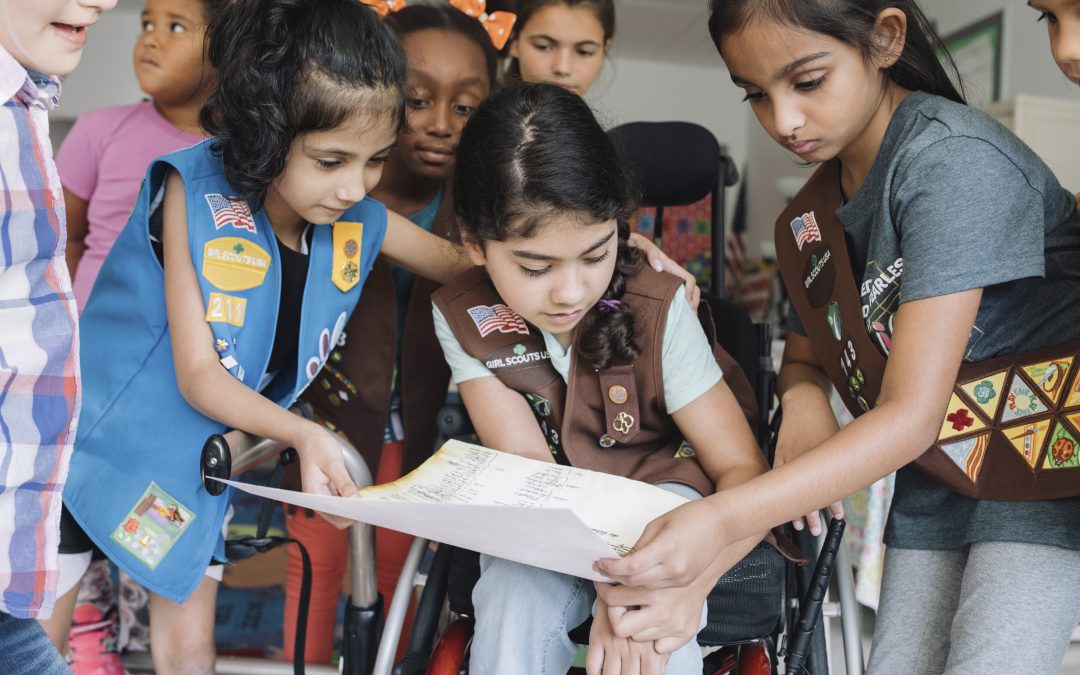I remember the moment a flyer came home in kindergarten with my daughter inviting “all girls” to join Girl Scouts, I remember asking myself if that invitation really included my girl, with all her unique abilities and limitations. I decided it had to. I attended an information night and asked questions about inclusion and troops open to having my daughter join. I wanted to make sure she was always included, challenged, and that her sister Girl Scouts grew as much from her as she did with them, so I decided to lead her troop myself. Our journey to becoming an inclusive troop has been a rewarding journey, so here are 5 tips to help your troop become more inclusive:
Pin this post for later!
1. Talk about inclusion with your girls and your school
Have a practical conversation with the girls in the troop about accessibility and inclusion: a hands-on activity (like the ones mentioned in Girl Scouts of Western Washington’s Inclusion Handbook) geared toward explaining that differences exist but are just as valuable as what they might consider typical, and that when we have advantages, we should use them to help others. My troop played a game where some girls started closer to the finish line than others, helping them visualize how these advantages impact how we get to the finish line.
Make sure people know your troop is open to girls of all abilities. When I add my troop to the catalog each year, I make a note at the bottom of our description that we are open to girls of all abilities. Recruit the help of supportive administrators and teachers (especially Special Education teachers) and let them know that you are open to having girls of all abilities. Sometimes a personal invitation is needed to let parents know that their child is really welcome.
2. Pick a meeting space that accommodates everyone
Consider if your meeting space can meet everyone’s needs. Is it truly handicap accessible—not just the front door, but the room and restrooms as well? Does it provide quiet spaces? Is it overstimulating? How can your meeting space evolve or change to meet the needs of everyone in the troop?
GSNorCal even has a section, “Meeting Place Considerations” in Volunteer Essentials that can help you in selecting a meeting site. They recommend finding a meeting space that “can accommodate girls with disabilities, as well as parents with disabilities who may come to meetings”. The section also has practical suggestions for finding a meeting space that meets the needs of all.
3. Communicate frequently with parents
Ask the girls’ parent or guardian for ideas and suggestions based on what she is working on at school. What are her Individual Education Plan goals? How can we translate these goals to the troop, to reinforce what she is learning at school in Girl Scouts? How can we apply Girl Scouts to school and make the goals transfer both ways? Have a talk with the girls’ parents about how you can make the Girl Scout curriculum accessible to them—it may require some small changes, but it’s all worth it in the pursuit of inclusive Girl Scouting. There are numerous websites and Facebook groups available to help leaders modify curriculum.
When I first started my troop, I decided that, in the spirit of Girl Scouts, if a girl attended a meeting (or any part of a meeting) and left because she needed to or couldn’t complete a task, that she would be awarded that badge. I explained that I hoped to expand our troop with girls of varying abilities, and this would be part of our troop’s experience. Everyone was very supportive and we were able to establish useful expectations through discussion of the troop.
4. Be flexible with your meeting structure
Some girls can’t stay for an entire meeting—and that’s ok. Be flexible with their limitations and offer them support. If they can’t stay for an entire meeting, allow them to stay for what they can, and take work home to be completed if and when they can.
If girls with different abilities become overwhelmed, have a backup plan. A technique I use for our troop is that I suddenly need a “helper”. I announce that I need a helper and pick the girl that needs some space. Usually this changes the energy of the room, and is enough to help everyone refocus and calm down. The helper can help me pass out papers, or take a minute to prep, or pass out snacks.
Consider shortening meetings for girls that need it. Work with families to decide what girls with different abilities can handle. If that’s 15 minutes, have her come, do what she can do, and be a part of the meeting before she has to go. Giving her a role such as “Meeting Opener” so she can always contribute, even if she can’t stay for the full meeting is a great way to keep her engaged and make her feel valuable. When she leaves, communicate with her family about the remaining requirements that should be met, while keeping the girl’s abilities in mind.
5. Be creative with your activities
Plan activities that allow the girls to lift each other up. My daughter cannot read or write, although she is in the fourth grade. When I hand out a writing assignment (something we don’t do too often), another girl in my troop immediately pairs up with her. They know that she needs a partner with such assignments, and they gladly fill in that need.
Replace book work with hands-on learning. Our troop tends to shy away from reading and writing; instead, we take field trips, have guest speakers for almost every meeting, and practice hands-on activities.
Not only should you be understanding of a girl’s need for a wheelchair, a hearing aid, a fidget toy, or any other assistive device, think about what regular devices can make activities easier for your girls. This past cookie season, outside my local grocery store, a Daisy Girl Scout approached me and handed me an iPad. It said: “Would you like to support Girl Scouts?” The customer clicked “yes” or “no” and then were taken to a screen where you could choose your cookies and have your total displayed. I chose my cookies and the girl got them for me. I spent a few minutes talking to the mom (also the leader of the troop) and she explained her daughter had limited speech and this device was provided by her school to help her with cookie sales. This device made cookie sales a possibility for this enterprising Daisy, when she might have otherwise been left out of a core Girl Scout experience. The opportunity to embrace technology and devices as solutions to our challenges can only help lead more inclusive troops.
Having an inclusive troop has enriched not only my daughter’s life, but the lives of her sister Girl Scouts. This past year, my daughter wanted to learn to count in multiples of fives so she could work at cookie booths without asking me for help. Her scholastic goals were changed so that her teacher focused on teaching her to count change for cookie boxes correctly. This year she learned how to multiply boxes of cookies and make correct change, because of Girl Scouts. My daughter brings so much to our troop, and the girls in our troop have learned an important lesson about treating others with different abilities with kindness and dignity. Juliette Gordon Low intended Girl Scouts to be a place for all girls—it’s in our heritage to have diverse groups of young women who encourage, support and build each other up, so let’s get inclusive!
What to do next:
- For a related read, check out How to Build and Maintain an Inclusive Girl Scout Troop as well as 12 Tips for Creating a Safe Space for Girls.
- Girl Scouts of Western Washington put together a comprehensive Inclusion Handbook: Focus on Ability that has everything from talking points to tips and resources.
- Learn more about how to create an inclusive troop culture with Autism Empowerment’s helpful Girl Scout-specific resources, like their document: Girl Scouts – A Place for Girls of All Abilities.
- Look into how you can support girls with special needs in your community, spread the word that your troop is open to girls of all abilities, and welcome them into Girl Scouts!
 Christina Bell—Christina is a stay-at-home mom and recent San Francisco State University graduate. Mother to three spirited children: Allison (12), Olivia (9) and Jake (8). She has lead her daughter Olivia’s troop for five years since its founding; incorporating fun field trips and guest speakers. Married for 15 years to her college sweetheart, they live in Brentwood. She is passionate about inclusion and volunteers as a community special needs advocate. Christina also enjoys traveling.
Christina Bell—Christina is a stay-at-home mom and recent San Francisco State University graduate. Mother to three spirited children: Allison (12), Olivia (9) and Jake (8). She has lead her daughter Olivia’s troop for five years since its founding; incorporating fun field trips and guest speakers. Married for 15 years to her college sweetheart, they live in Brentwood. She is passionate about inclusion and volunteers as a community special needs advocate. Christina also enjoys traveling.


Our long-ago Cadette troop had three criteria:
1. Is she breathing?
2. Is she Cadette age?
3. Does she want to try and live by the GS Promise and Laws?
Do you suppose that’s why we had girls of all races, religions, and those who denied they were “handicapped” because they happened to be blind, deaf, used prosthetic devices, or were in “special ed”?